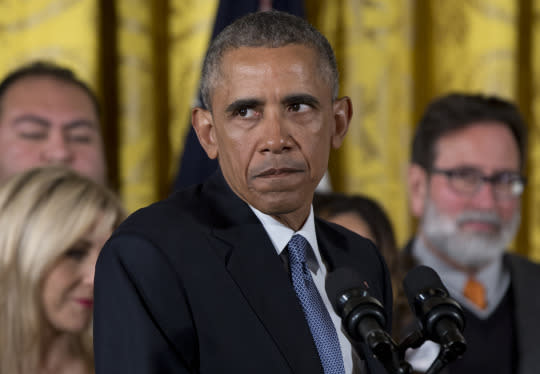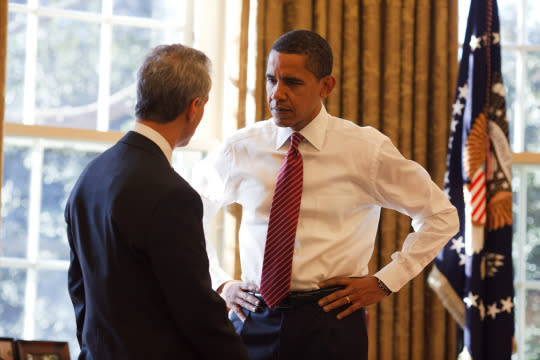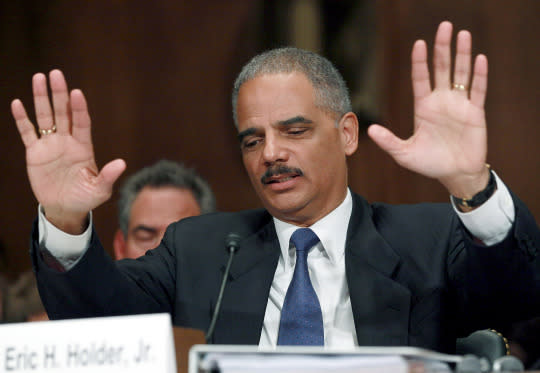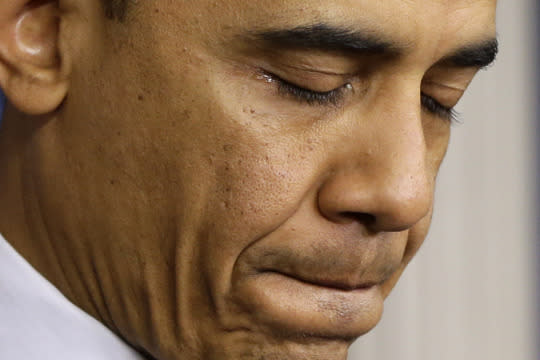How Obama pulled the trigger on gun control

President Obama pauses as he speaks at the White House about steps his administration is taking to reduce gun violence. (Photo: Carolyn Kaster/AP)
It was barely a month into Barack Obama’s presidency when his then attorney general, Eric Holder, figured it was time to raise a touchy, but important, subject — the proliferation of high-powered guns.
The administration would soon be pushing to reinstate a ban on so-called assault weapons, Holder told reporters at a Feb. 27, 2009, press conference announcing charges against members of Mexico’s Sinaloa cartel — the vicious criminal syndicate, headed by then fugitive drug lord Joaquín “El Chapo” Guzmán, that was amassing an arsenal of weapons from U.S. gun dealers in border states.
After all, Holder noted, “it is something the president talked about during the campaign.”
The AG, it turned out, was off message. No sooner did he speak those words than a stern directive came down from White House aides under orders from then chief of staff Rahm Emanuel. “They told him to shut up,” recalled one former senior administration official who was privy to communications between the White House and the Justice Department. “The message was ‘Don’t talk about guns.’ It was pretty clear and direct. There wasn’t a lot of nuance there.”
The now largely forgotten incident underscores the dramatic evolution in President Obama’s approach to gun violence. Tonight, Obama will give his last State of the Union address and will highlight his renewed commitment to enacting “common sense” gun control measures, leaving open an empty seat in the gallery as a symbol of Americans killed by gun violence. It is a subject that the president has spoken about with uncommon passion in recent days: He denounced what he called “the gun lobby’s lies” during a televised forum on the subject. He welled up with tears as he announced new executive actions he was planning to require more extensive background checks and other steps aimed at curbing a “national crisis” of gun shootings.

Obama with chief of staff Rahm Emanuel in the Oval Office. (Photo: Pete Souza/The White House)
But in the early days of his presidency, the entire subject was off-limits inside the White House — a stark example of how politics and circumstances can shape, and reshape, presidential agendas. At the time, gun control was viewed by Emanuel and other senior aides as an unwelcome distraction from Obama’s more pressing priorities — winning passage of an economic stimulus bill and health care reform. Pushing gun control measures, they feared, would rile up the powerful National Rifle Association and endanger rural “blue dog” Democrats whose support was crucial to the White House.
“The Democratic Party understands this is a losing issue … it’s a dead loser,” then Rep. Dan Boren, an Oklahoma Democrat who had just been elected to the NRA board, told Newsweek magazine at the time.
After Holder made his unwelcome remarks, Sen. Max Baucus, a Democrat from Montana who was crucial to the White House’s efforts to win passage of health care reform, issued a terse press release: “Senators to Attorney General: Stay Away from Our Guns,” it read, in part.
The issue soon became even more toxic after federal gun agents, working closely with the U.S. attorney’s office in Arizona, launched an undercover operation aimed at tracking “straw buyers” for the Mexican drug cartels who were illegally buying AR-15 and other assault rifles from U.S. gun dealers. Code-named “Fast and Furious,” the plan turned into a law enforcement fiasco: Agents of the Bureau of Alcohol, Tobacco and Firearms lost track of hundreds of the weapons and one was later linked to the death of a U.S. border patrol agent. Republicans in Congress launched investigations, claiming Fast and Furious was part of a White House “conspiracy” to build support for gun control. They subpoenaed documents from Justice and, when he failed to turn them over, voted to hold Holder in contempt.
By the time Obama was preparing to run for reelection, Fast and Furious was being routinely cited by the NRA and other conservative groups as one of the “scandals” of his presidency — and any suggestion of gun control was moved even further to the bottom of the White House agenda. When the president gave his State of the Union address in January 2012, the words “guns” or “gun violence” were never mentioned, just as they had not been the year before.

Attorney General Eric Holder during a Senate Judiciary Committee hearing on the Fast and Furious program to combat gun running. (Photo: Mark Wilson/Getty Images)
What changed was the seemingly endless series of gun massacres that, according to those who have spoken to him, had a visceral impact on the president. The Jan. 8, 2011, massacre at a Tucson parking lot — in which six people, including a federal judge, were killed and U.S. Rep. Gabrielle Giffords was badly wounded, did not initially prod the president into action. But the rampages didn’t stop. On July 20, 2012, a deranged gunman, James Eagan Holmes, using a semi-automatic rifle and two handguns, opened fire in a movie theater in Aurora, Colo., killing 12 people and injuring 70. Then, that December, Newtown: 20-year-old Adam Lanza, equipped with a Bushmaster semiautomatic rifle and a Glock pistol, killed 20 first-graders (ages 6 and 7) and six adult staff members at Sandy Hook Elementary School in Connecticut, a gut-wrenching event that brought the president to tears.
“I don’t think you can underestimate the degree to which Obama and [Vice President Joe] Biden were personally affected by Newtown,” said Kristen Rand, vice president of the Violence Policy Center, a gun control group that has worked with, and occasionally criticized, the White House on the issue. “The whole atmosphere changed. There was a honest recognition among the public about just how awful this problem is.”
In the wake of Newtown, the White House finally began to push Congress to take steps to curb gun violence. The president proposed legislation to close background check loopholes and reinstate the assault weapons ban.
But even then, there were limits. U.S. counterterrorism officials quietly proposed what they considered another modest step — barring those on the U.S. government’s terrorism watch list from purchasing firearms. The proposal was prompted by instances where suspected terrorist operatives were observed entering gun stores and purchasing weapons. “We could actually watch them doing this — and there was nothing we can do,” recalled one former top U.S. counterterrorism official, expressing his frustration.

Obama during comments at the White House about the school shooting in Newtown, Conn. (Photo: Charles Dharapak/AP)
In the aftermath of Newtown, a proposal from the National Counterterrorism Center to halt such sales was sent to the White House. But once again it was apparently viewed as politically impractical and ignored, a source directly familiar with the matter tells Yahoo News. (The White House did not respond to a request for comment.)
Today, the atmosphere inside the White House has clearly changed. Obama has made clear he wants curbing gun violence to be part of his legacy and central to his last year’s agenda. He now talks openly about taking steps to ban gun sales to those on the watch list. “What could possibly be the argument for allowing a terror suspect to buy a semiautomatic gun?” he asked in a speech last month after the San Bernardino massacre.
To be sure, such a step would almost certainly require legislation — and would likely be subject to constitutional challenges. And, as one former Obama law enforcement official said last week, it is worth noting that the president did not become engaged on the issue until he no longer had to run for reelection — and blue dog Democrats (whose support he once needed) have all but disappeared from the Congress, having either been defeated for reelection or (like Dan Boren and Max Baucus) given up their seats. Still, for Obama, on the subject of guns, the stars — including the policy and the politics — are now in alignment.
Watch the State of the Union right here.

